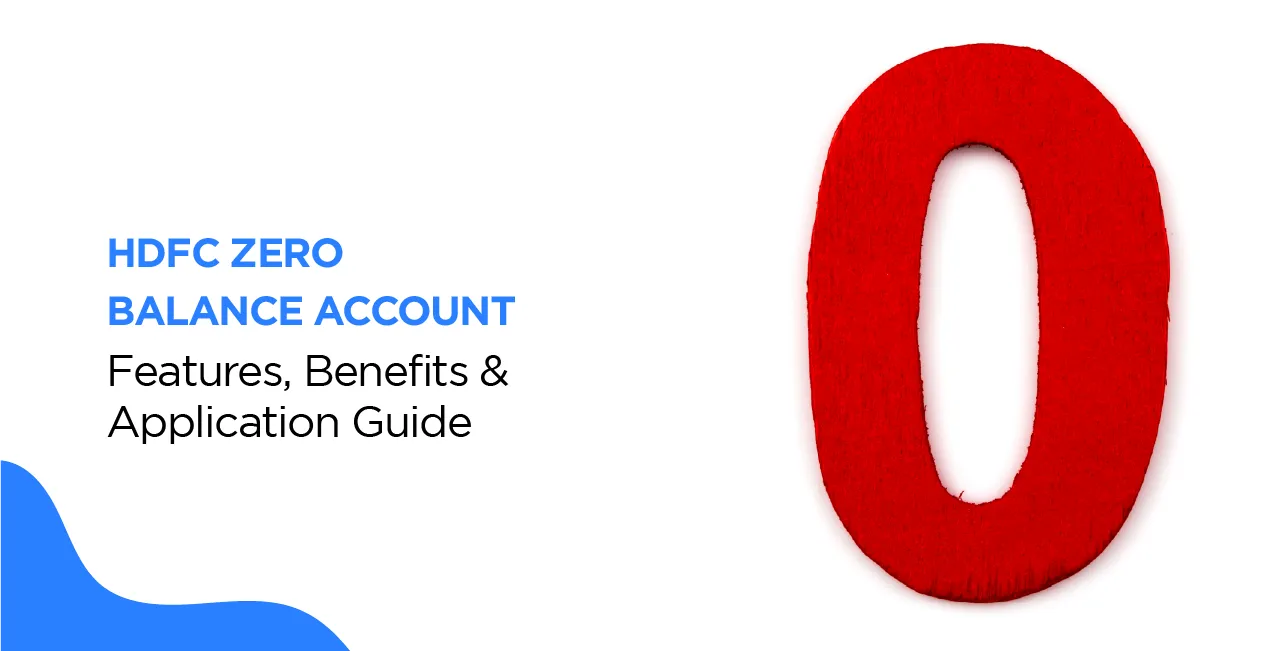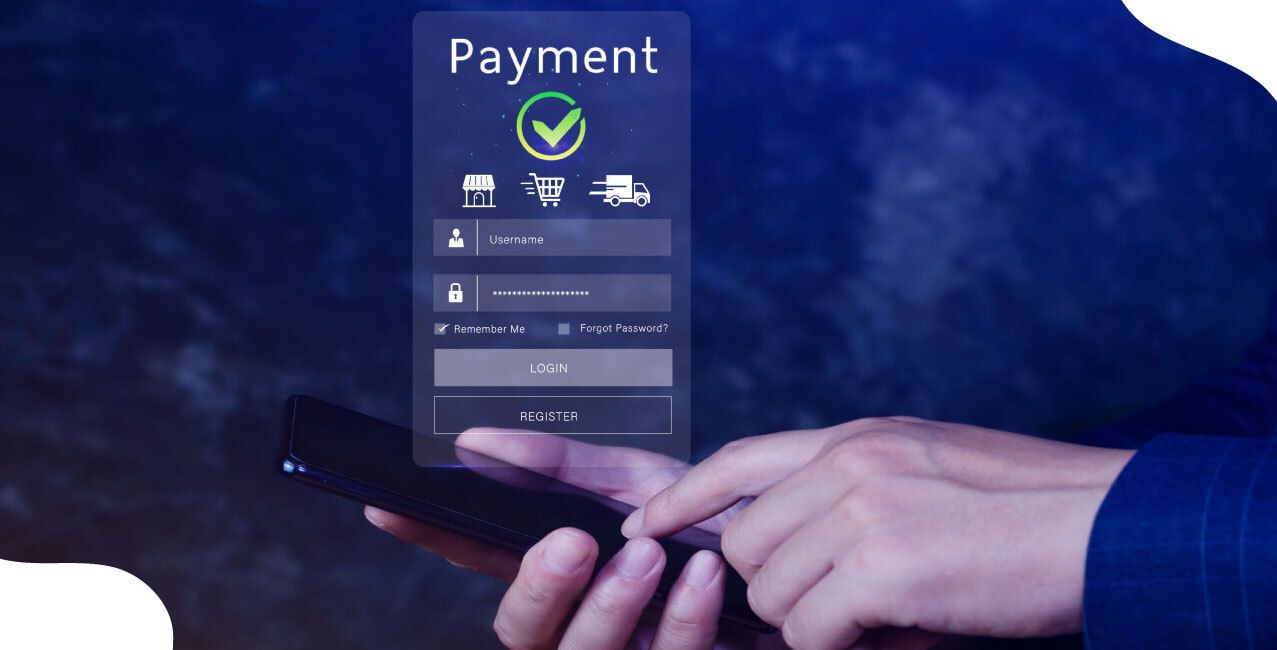
Author
LoansJagat Team
Read Time
12 Min
31 Mar 2025
HDFC Zero Balance Account – Features, Benefits & Application Guide
A Zero Balance Account is a type of bank account that allows users to access banking services without maintaining a minimum balance. HDFC Bank offers this facility to enhance financial inclusion, ensuring hassle-free banking for all.
Let’s understand it with the help of an example of Priya, a Customer Support Executive.
Priya earns a monthly salary of ₹30,000. Previously, she had a regular savings account that required her to maintain a minimum balance of ₹10,000. Due to her monthly expenses, she often struggled to meet this requirement and incurred penalties.
To avoid this, Priya switched to an HDFC Zero Balance Account, which enabled her to manage her salary and expenses without the stress of penalties.
Monthly Income & Expense Breakdown:
Income/Expense Category | Amount |
Salary (credited on the 1st of the month) | ₹30,000 |
Rent Payment | ₹10,000 |
Food & Groceries | ₹6,000 |
Electricity & Internet Bills | ₹2,500 |
Transport (Fuel/Public Transport) | ₹3,000 |
Entertainment & Shopping | ₹4,000 |
Savings (Remaining Balance) | ₹4,500 |
Types of HDFC Zero Balance Account
Type of Account | Features & Benefits |
Basic Savings Bank Deposit Account (BSBDA) | No minimum balance required, free ATM/Debit Card, NetBanking, Mobile Banking, and SMS alerts. |
Salary Account | Offered to employees of partnered companies, salary credited directly, free fund transfers, online banking, and special offers on loans and credit cards. |
Government Scheme Accounts (PMJDY, etc.) | Opened under government schemes, includes insurance coverage, an overdraft facility, and a RuPay debit card. |
Kids’ Savings Account | It helps parents save for their children’s future. It comes with a free ATM card, online banking, and no minimum balance requirement. |
Women’s Zero Balance Account (Special Schemes) | Tailored for women with benefits like cashback on shopping, higher interest rates, and discounts on loans. |
With HDFC Bank InstaAccount, you can open a zero-balance savings account instantly with pre-enabled NetBanking, Mobile Banking, and Cardless Cash Withdrawals, making banking simple and hassle-free.
How to Open an HDFC Bank Zero Balance Account Online?
Step 1: Visit the official website of HDFC Bank.
Step 2: Scroll down, and you will see a navbar in which you will see a section “Save.” Hover on that, and you will see a section called “Accounts” on the left-hand side, under which you will see “Savings Account” at the top.
Step 3: Click on that, and you will be directed to a new page. Scroll down and under the section of “Savings Account,” you will see an option “View more.” Click on that and scroll down.
Step 4: You will see a “Click here” hyperlink. Click on that, and you will see a new interface where you have to fill in all the details that are required to open an account.
Step 5: After filling in all the details, your HDFC Bank Savings Account will be opened.
Read More - HDFC Bank Account Opening
How to Open an HDFC Bank Zero Balance Account Offline?
Opening an HDFC Bank Zero Balance Account offline is a simple process. Follow these steps:
Step 1: Visit the Nearest HDFC Bank Branch
Go to your nearest HDFC Bank branch and ask for a zero balance savings account opening form (such as BSBDA or Salary Account).
Step 2: Submit Required Documents
Provide the necessary KYC documents, including:
- Aadhaar Card (as identity & address proof)
- PAN Card (mandatory for account opening)
- Passport-size Photographs
Step 3: Fill Out the Application Form
Complete the account opening form with personal details like name, address, date of birth, and nominee details.
Step 4: Verification Process
The bank will verify your KYC documents and application details. If required, they may ask for additional documents.
Step 5: Receive Account Details
Once verified, your zero-balance account will be activated, and you will receive:
- Account Number & Customer ID
- ATM/Debit Card & Passbook
- NetBanking & Mobile Banking Activation Details
After successful activation, you can start using your HDFC Bank Zero Balance Account for transactions, withdrawals, and online banking services.
HDFC Bank Zero Balance Account Fees & Charges
Description | Charges |
Minimum Balance | NIL |
Non-Maintenance Charges | NA |
Cheque Book | Free - 25 leaves/year; Extra: ₹100 (₹75 for senior citizens) |
Duplicate/Adhoc Statements | Soft Copy - Free; Physical Copy: ₹100 (Branch), ₹75 (PhoneBanking Non-IVR), ₹50 (IVR/NetBanking/ATM) |
Passbook Issuance | Free; Duplicate - ₹100 |
Demand Drafts (DD) & Manager’s Cheque | Issuance: ₹50 (up to ₹10,000), ₹5 per ₹1000 (min ₹75, max ₹10,000); Cancellation: ₹100 (₹60 for senior citizens) |
Cheque Collection (Outstation) | ₹25 (up to ₹5,000), ₹50 (₹5,000-₹10,000), ₹100 (₹10,000-₹1,00,000), ₹150 (above ₹1,00,000) |
Cheque Return Charges (Due to Insufficient Funds) | 1st: ₹450 (₹400 for Sr. Citizens), 2nd: ₹500 (₹450 for Sr. Citizens), 3rd+: ₹550 (₹500 for Sr. Citizens) |
Balance Enquiry (Branch) | Free |
Balance Certificate | Free (Current Year), ₹100 (₹90 for Sr. Citizens) |
Interest Certificate | ₹100 (₹90 for Sr. Citizens) |
TDS Certificate | Free |
Account Closure | 14 days: Free; 15 days-12 months: ₹500 (₹300 for Sr. Citizens) 12 months: Free |
Photo Attestation | ₹100 (Free for Sr. Citizens) |
Address Confirmation | ₹100 (₹90 for Sr. Citizens) |
Stop Payment Charges | ₹100 (Particular cheque), ₹200 (Range of cheques); Free via NetBanking |
Standing Instructions | ₹25 per transaction + remittance charge |
Dormant Account Activation | Free |
ATM/Debit Card Issuance | Free |
ATM Card Replacement | ₹200 + Taxes |
International ATM Transactions | Balance Enquiry: ₹25, Cash Withdrawal: ₹125 |
Declined Transactions (Insufficient Funds) | ₹25 per transaction |
Bill Payment via NetBanking | Free |
NEFT (Branch) | ₹2 (up to ₹1,00,000), ₹10 (above ₹1,00,000) |
NEFT (Online) | Free |
RTGS (Branch) | ₹15 (₹2,00,000 & above) |
RTGS (Online) | Free |
IMPS (Outward) | ₹5 (₹1-₹1,00,000), ₹15 (above ₹1,00,000-₹2,00,000) |
SMS Alerts | ₹3 per quarter |
Cheque Withdrawal Limits | 4 free withdrawals/month, ₹150 for 5th+ transaction |
Third-Party Cash Transactions | ₹25,000/day limit; Above ₹25,000 not allowed |
HDFC Bank Zero Balance Account Interest Rates
Domestic, NRO, and NRE Savings Account Interest Rates
Savings Account Balance | Interest Rate (p.a.) |
Less than ₹5,000,000 | 3.00% |
₹5,000,000 & above | 3.50% |
Note:
- Interest is calculated daily based on the closing balance in your account.
- The accumulated interest is credited quarterly.
Example: HDFC Bank Zero Balance Savings Account Interest Calculation
Mr. Arjun Khanna’s Interest Earnings
Mr. Arjun Khanna, a 45-year-old businessman from Bangalore, has deposited ₹12,00,000 in his HDFC Bank Zero Balance Savings
Account. He aims to estimate his monthly interest earnings based on the bank’s interest rate structure.
Savings Account Balance (₹) | Interest Rate (p.a.) | Amount in Slab (₹) | Interest Earned (p.a.) (₹) |
Less than ₹5,000,000 | 3.00% | 12,00,000 | 36,000 |
₹5,000,000 & above | 3.50% | 0 | 0 |
Total Balance: ₹12,00,000 | — | 12,00,000 | ₹36,000 per year |
Monthly Interest Calculation:
- Annual Interest Earned: ₹36,000
- Monthly Interest: ₹36,000 ÷ 12 = ₹3,000
Since Arjun maintains this balance consistently, he earns approximately ₹3,000 per month as interest, which is credited quarterly to his account.
What is a Savings Account Interest Rate?
A Savings Account interest rate refers to the percentage of interest a bank pays on the funds deposited in a Savings Account. These accounts offer the flexibility to deposit and withdraw money at any time while continuing to earn interest as long as there is a balance in the account.
Banks calculate interest on the daily balance or monthly average balance, depending on their policy. The interest is usually credited quarterly or monthly. Factors like economic conditions, RBI regulations, and bank policies affect interest rates. Some banks offer higher rates for higher balances or special accounts, enhancing savings benefits for account holders.
For example, if a bank offers a 3.5% annual interest rate and you maintain a balance of ₹50,000, the interest earned in a year would be ₹1,750. Some banks calculate interest daily based on the closing balance, while others use the monthly average balance. Higher balances or premium accounts may earn better rates.
Eligibility Criteria for HDFC Bank Zero Balance Account Opening
The following individuals and entities are eligible to open a Basic Savings Bank Deposit Account (BSBDA):
Eligibility Criteria | Details |
Resident Individuals | Can open the account individually or jointly. |
Hindu Undivided Families (HUFs) | Eligible to open an account under the name of the HUF. |
Minors (Above 10 Years of Age) | Can open a self-operated minor account. Eligible to receive an ATM/Debit Card for independent transactions. |
No Existing BSBDA Account | The applicant must not have a BSBDA account with any other bank. |
No Other Savings Account in HDFC Bank | Customers should not hold any other Savings Account with HDFC Bank. |
Minimum Balance Requirement
Requirement | Details |
Initial Deposit | No initial deposit is required to open the account. |
Minimum Balance | No minimum balance requirement. |
Average Monthly Balance (AMB) | Not required. |
This account provides essential banking services without the obligation to maintain a minimum balance, making it an ideal choice for individuals seeking hassle-free banking.
Example: Opening an HDFC Bank Zero Balance Savings Account
Mr. Amit Verma, a 35-year-old Indian citizen, wants to open an HDFC Bank Zero Balance Savings Account. To ensure he qualifies, he checks the eligibility criteria and matches them with his details:
Eligibility Check-
Eligibility Criteria | Amit Verma’s Details | Status |
Residency & Nationality | Indian Resident | Meets Criteria |
Mandatory Documents | Aadhar No: XXXX-XXXX-1234, PAN No: ABCDE1234F | Meets Criteria |
Mobile Number Requirement | +91-9876543210 (Linked with Aadhaar) | Meets Criteria |
Location Criteria | Delhi (HDFC Bank Branch Present) | Meets Criteria |
Existing Account Restriction | No existing savings account or BSBDA with HDFC Bank | Meets Criteria |
Since Amit meets all the requirements, he proceeds with the online application. He enters his details, completes Aadhaar OTP verification, and successfully opens his HDFC Bank Zero Balance Savings Account.
Within 24 hours, he receives his account number: 1234567890 and IFSC code: HDFC0001234, allowing him to start banking instantly.
Required Documents for HDFC Zero Balance Account Opening
As per banking regulations, the following documents are considered Officially Valid Documents (OVD):
S.No | Document Name |
1 | Passport |
2 | Driving Licence |
3 | Proof of possession of Aadhaar (as issued by UIDAI) |
4 | Voter's Identity Card issued by the Election Commission of India |
5 | Job card issued by NREGA, duly signed by an officer of the State Government |
6 | A letter issued by the National Population Register containing details of name and address |
Note:
Proof of possession of Aadhaar includes any of the following:
- Aadhaar letter issued by UIDAI
- E-Aadhaar (only if downloaded from the UIDAI website)
- Aadhaar Secure QR Code
- Aadhaar Paperless Offline e-KYC
Also Read – HDFC Bank Zero Balance Account
Deemed OVDs for Proof of Address (Valid for 3 Months)
If the OVD submitted does not contain the updated address, the following documents can be submitted for the limited purpose of proof of address (valid for 3 months):
Document Name | Conditions |
Utility Bill | Should not be more than 2 months old. Includes bills for electricity, telephone, post-paid mobile phone, piped gas, and water. |
Property or Municipal Tax Receipt | It should be recent and valid. |
Pension or Family Pension Payment Orders (PPOs) | Issued by Government Departments or Public Sector Undertakings (PSUs), provided they contain the applicant’s address. |
Letter of Allotment of Accommodation | Issued by State Government/Central Government Departments, statutory or regulatory bodies, PSUs, scheduled commercial banks, financial institutions, or listed companies. Also includes leave and licence agreements. |
Example - Mr. Rohan Mehta’s Account Opening Process
Mr. Rohan Mehta, a 30-year-old IT Consultant from Pune, India, wanted to open an HDFC Bank Zero Balance Savings Account for seamless online transactions.
Documents Submitted for Account Opening
Required Document | Rohan’s Submitted Document | Status |
Proof of Identity & Address (OVD) | Aadhaar Card (Issued by UIDAI) | Accepted |
Additional Proof of Address (Deemed OVD) | Electricity Bill (Last 2 Months) | Accepted |
Since Rohan's Aadhaar Card had his previous address, he submitted an electricity bill (issued within the last 2 months) as proof of his updated address.
Application Process & Account Activation
- Rohan submitted his documents online through the HDFC Bank portal.
- Completed Aadhaar OTP verification for e-KYC.
- Within 24 hours, he received his account number and IFSC code, enabling him to start using his HDFC Zero Balance Account immediately.
By using valid OVDs and deemed OVDs, Rohan successfully opened his HDFC Bank Zero Balance Savings Account without any hassle.
HDFC Bank Zero Balance Account Helpline
HDFC Bank customers can contact our toll-free helpline for any queries, assistance, or to resolve grievances.
Toll-Free Numbers (Accessible Across India)
- 1800-1600
- 1800-2600
These numbers are available nationwide, ensuring convenient access to the customer support services.
Helpline for Customers Traveling Abroad
If you are outside India, you can reach the bank at:
+91 22 6160 6160
Note: Call charges may apply as per your service provider’s tariff plan.
For a hassle-free banking experience, always contact the bank through our official helpline numbers.
HDFC Bank Zero Balance Welcome Kit
1. Customer ID
- Unique identification number required for NetBanking, PhoneBanking, and MobileBanking.
- Found in the Welcome Letter and on the first page of your chequebook.
- If you haven't received the Welcome Kit, check your Welcome Letter sent earlier.
- Keep it confidential and do not share it with anyone.
2. Debit/ATM Card
- Used for cash withdrawals, online transactions, and purchases.
3. Debit/ATM Card PIN
- Personal Identification Number (PIN) required for ATM withdrawals and POS transactions.
4. Internet Banking Password (IPIN)
- A password is required to access NetBanking for online banking transactions.
5. Telephone Identification Number (TIN)
- Used for authentication while using PhoneBanking services.
6. Chequebook
- Contains multiple cheques for account transactions.
Example: Understanding the HDFC Bank Zero Balance Welcome Kit
Mr. Sameer Gupta’s Banking Experience
Mr. Sameer Gupta, a 26-year-old software engineer from Bangalore, India, recently opened an HDFC Bank Zero Balance Savings
Account to manage his daily transactions efficiently. After completing the account opening process, he received his Welcome Kit, which included the following essentials:
Item | Details |
Customer ID | found in the Welcome Letter and on the first page of the chequebook. Essential for NetBanking, PhoneBanking, and MobileBanking. Kept confidential for security. |
Debit/ATM Card | Allows cash withdrawals from ATMs, online and offline purchases, and other banking transactions. |
Debit/ATM Card PIN | Required for ATM withdrawals and POS transactions. Changed the default PIN immediately at an HDFC ATM for security. |
Internet Banking Password (IPIN) | Enables access to HDFC NetBanking for online transactions, fund transfers, and bill payments. |
Telephone Identification Number (TIN) | Used for authentication when using PhoneBanking services. |
Chequebook | Includes multiple cheques for manual account transactions when needed. |
By carefully reviewing the items in his HDFC Zero Balance Welcome Kit, Sameer ensured a smooth banking experience while keeping his credentials secure.
Conclusion
The HDFC Bank Zero Balance Account is a convenient and accessible banking solution designed for individuals who want to enjoy banking services without the need to maintain a minimum balance. It offers a secure and hassle-free way to manage your finances while providing essential banking benefits such as a free Debit/ATM card, Internet Banking, Phone Banking, and a chequebook.
With no initial deposit requirement and zero maintenance charges, this account is ideal for students, salaried employees, and individuals seeking a basic yet efficient banking experience. Additionally, HDFC Bank ensures seamless customer support and a wide range of banking facilities to meet the diverse needs of its customers.
By opting for an HDFC Bank Zero Balance Account, customers can enjoy a smooth and reliable banking experience with the convenience of digital and branch banking services.
FAQ’s
1. Who can open an HDFC Zero Balance Account?
Any resident individual, including salaried employees, students, and senior citizens, can open an HDFC Zero Balance Account, provided they meet the bank’s eligibility criteria.
2. Does the account come with a debit card?
Yes, the account includes a free Debit/ATM card, allowing customers to withdraw cash, shop online, and access various banking services conveniently.
3. Is there any initial deposit required?
No, an HDFC Zero Balance Account does not require any initial deposit or minimum balance maintenance, making it a hassle-free banking option.
Other Zero Balance Accounts | |||
About the Author

LoansJagat Team
‘Simplify Finance for Everyone.’ This is the common goal of our team, as we try to explain any topic with relatable examples. From personal to business finance, managing EMIs to becoming debt-free, we do extensive research on each and every parameter, so you don’t have to. Scroll up and have a look at what 15+ years of experience in the BFSI sector looks like.

Quick Apply Loan
Subscribe Now
Related Blog Post


